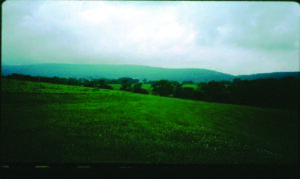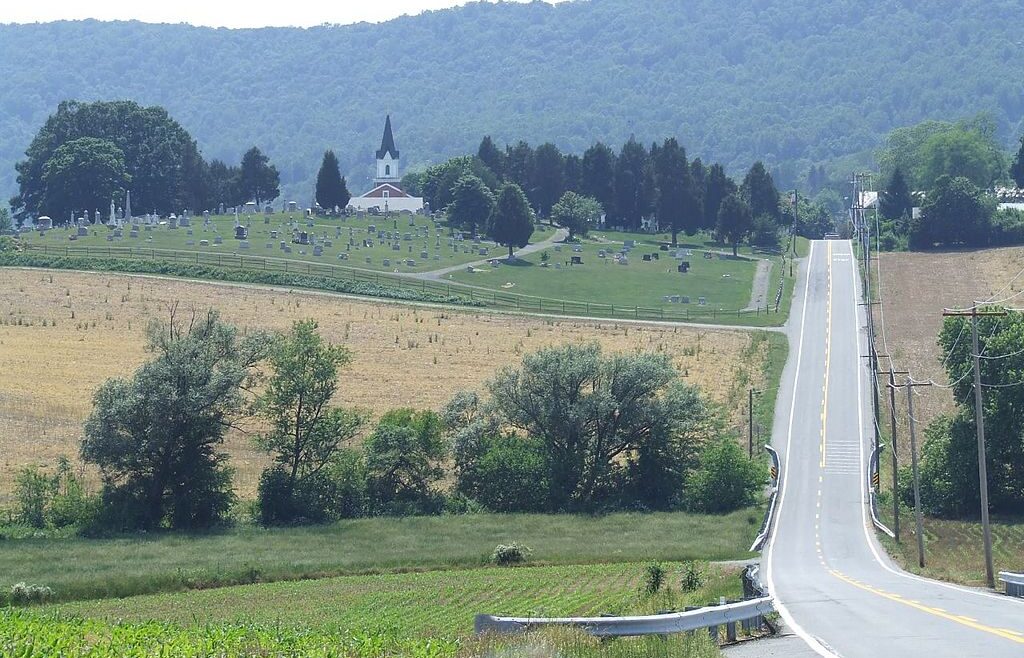Scenic Easements for the Berman Property
About the Property
In 1993 the State of Maryland began a campaign to protect the surroundings and viewsheds of Civil War battlefields from development. Efforts centered around South Mountain, in Frederick County, and Antietam, in Washington County. Eventually, a partnership was formed between the Maryland Environmental Trust, as easement holder; the Maryland State Highway Administration, as a conduit for Federal Intermodal Surface Transportation Enhancement Act (ISTEA) funds; and the Department of Natural Resources, which provided funding to match the Federal funding.
A priority property at South Mountain at Burkittsville was the 250-acre Berman Farm, which protects the viewshed at South Mountain, the historic Village of Burkittsville, and two fine pre-Civil War houses. The landowner, who had owned the farm for many years, was receptive to the idea of entering into an easement that contained restrictions on construction in sensitive viewshed areas and changes to the historic structures.

The Land Trust
The Maryland Environmental Trust (MET) is a statewide local land trust governed by a citizen Board of Trustees. The Trust focuses on preserving natural resources, open space, and agricultural lands through the use of conservation easements. The Trust also helps local land trusts and provides grants for environmental education programs.
The Easement
The Trust and the landowner jointly signed the easement protecting the farm on January 7, 1998. The easement is not a scenic easement per se, i.e., one drafted specifically to comply with the appropriate sections of the Internal Revenue Code, but rather a standard conservation easement; however, there are enough elements in the easement to indicate that the arrangement plays a substantial role in protecting vital scenic assets for the South Mountain area.
What Scenic Resources Does the Easement Protect?
The easement protects two key scenic resources. First, according to the summary of conservation values, “the property is an important part of the rural historic landscape of South Mountain and protection of the Rural Historic Village of Burkittsville and its viewshed.” Second, the farm itself includes several historic structures dating from the 1850s. During the 1862 Civil War Battle of South Mountain, the rival armies requisitioned buildings on the farm for use as hospitals to treat wounded soldiers.

Key Scenic Conservation Strengths of the Easement
There are several components in the easement that protect the scenic resources on the property. While most easements prohibit commercial billboards, this particular easement adds a bit of consideration for the impact of smaller identification signs. Specifically, it prohibits signs of any kind larger than 4 feet by 4 feet and provides that multiple signs must be at least 75 feet apart, not damage living trees, and comply with all local regulations.
The easement does not specifically prohibit cell towers, wind turbines, and other scenic-resource disruptions. However, it does prohibit any new buildings except for accessory structures to existing residences and agricultural operations. Since the largest of cell towers and most wind turbines require some sort of accessory structures or equipment sheds, this prohibition should preclude new towers on the property.
Perhaps the most important provisions for protecting the distinctive character of the property are the restrictions on changes to the quality of the historic buildings and the quality control provisions for new accessory structures. The easement allows new structures only so long as “they do not interfere with the historic character of the property and the viewshed of South Mountain Battlefield as determined by the grantee.” Furthermore, the landowner must maintain the brick manor house and the brick farm/spring house in the same or better condition as they were on January 7, 1998. Those two measures ensure that the historic and visual integrity of the property will remain the same and possibly even improve in the future.
Potential Weaknesses of the Easement
Ironically, one of the easement’s greatest strengths is also a potential target for attack if an unscrupulous future landowner seeks to break the easement. The provision that the land trust must determine whether or not a structure interferes with the character of the property or the viewshed of South Mountain Battlefield begs the question “by what standards?” In some court cases, a failure to set standards has led to judges overturning or holding laws unconstitutional. However, in private contract matters, including conservation easements, courts allow far more flexibility. Therefore, while there is the potential for a problem with that provision, the potential is rather slight.
One other potential problem, though there are enough provisions to mitigate it, is that the easement fails to specifically prohibit such uses as telecommunications towers and wind turbines. While Scenic America recognizes that modifying existing easements can be a difficult process, we strongly encourage drafters of new easements to prohibit or at the very least include strong design criteria for such uses.
Key Enforcement Clauses and Other Noteworthy Procedural Language
Most enforcement language in scenic easements tends to be fairly boilerplate, in the “notice and litigate” mode. However, there are two provisions in this easement that particularly help the property. First is the requirement that the Trust determines whether or not new structures interfere with the character of the property and the viewshed. Second, the enforcement clauses per se stipulate that, in the event of a breach of the easement, the landowner is responsible for all costs of restoring the property to its original condition or better.
Conclusion and Assessment
With its position in the viewshed of both a Civil War battlefield of note and a historic rural village, near the Appalachian Trail and adjacent to other protected lands, and with its historic buildings, the Berman Farm in Frederick County, Maryland is a noteworthy scenic resource. While the easement that the Maryland Environmental Trust developed to protect the property is not a scenic easement qualifying under the appropriate sections of the Internal Revenue Code, it does stand out as a conservation easement that takes great pains to protect the scenic values and integrity of the property.